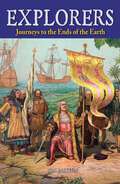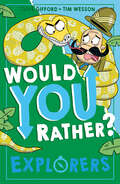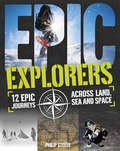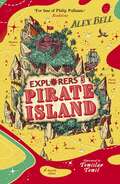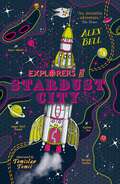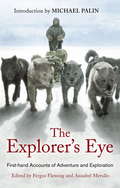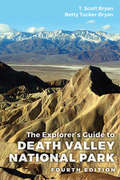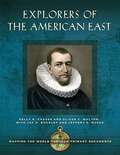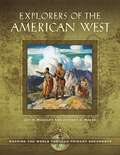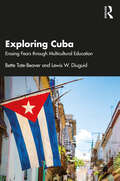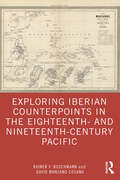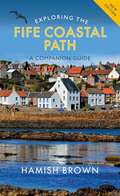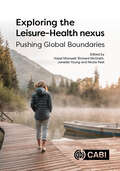- Table View
- List View
Explorers: Journeys to the Ends of the Earth
by Jon BalchinFascinated by what lies beyond the boundaries of human experience, men and women have throughout history been irresisibly drawn to venture into the unknown. Explorers charts the astonishing feats of history's most intrepid pathfinders. From the early voyages of the Ancient Greek mariner Colaeus, who first discovered that beyond the Mediterranean lay a far greater ocean, to the compelling tale of the race for the poles. this book encompasses the discovery and exploration of the great continents and oceans of the world. Whether motivated by the prospect of conquest, the spirit of scientific inquiry, nationalism, fanaticism, or just plain curiosity, the explorers in this book dared to seek out the most remote and inhospitable places on Earth and in so doing changed forever our perception of the planet.
Explorers (Would You Rather? #4)
by Clive GiffordWould you rather ride a hot-air balloon to the North Pole or cycle to the South Pole? Go to the toilet inside your spacecraft, or outside it? Only you can decide!
Explorers: Explorers (Epic! #1)
by Philip SteeleEpic: Explorers focuses on 12 of the most incredible expeditions in history, from the ancient Egyptian voyage to the land of Punt around 1470 BCE to the Apollo mission to space in 1969; taking in Marco Polo's journey to China, the great 15th-century Chinese voyages, the Portuguese sailing around the Cape of Good Hope, the New World voyages, the circumnavigation of the globe, the mapping of the Pacific, the exploration of the American West, the exploration of Africa, the race to the South Pole and the descent into the Mariana Trench on the way.The book details the dates and location of each expedition, the people involved and the distances travelled. A timeline on every spread gives the key dates from each expedition, and what happened when. Additional background information to each expedition leader is also provided, including Hatshepsut, Marco Polo, Zheng He, Christopher Columbus, Bartolomeu Dias, Vasco da Gama, Ferdinand Magellan, Captain James Cook, Meriwether Lewis, William Clark, Dr Livingstone, Henry Morton Stanley, Mary Kingsley, Robert Scott, Roald Amundsen, Jacques Picard, James Cameron, Neil Armstrong, Michael Collins and Buzz Aldrin.Epic: Explorers also looks at the technology and vehicles involved in each expedition, from the Chinese treasure ships and the American canoes to the skis and dog sleds used on the South Pole expedition, and the rocket that carried the astronauts to the Moon. The dangers the adventurers faced are also catalogued, from the deserts, robbers and storms Marco Polo braved on his journey to China, to the lions, crocodiles and diseases Stanley and Livingstone battled in Africa.Infographic elements on each spread present information in a simple and highly visual way. Clear, concise text and a bright, appealing design make the book the perfect resource for project work on exploration, geography or history, or simply a great leisure read, for children aged 9 and above.For more epic events, try reading the other titles in the Epic series: Animal Migrations, Battles and Empires.
Explorers at Pirate Island (The Explorers' Clubs #5)
by Alex BellIn their fifth thrilling adventure, the explorers journey deep into the Bubble Ocean on their quest to stop the evil Collector, but time is running out . . .The Poison Tentacle Sea was home to the powerful Bone Current. As they had feared, it gave a sudden surge and pulled them in.Half-mermaid Ursula Jellyfin has always longed for adventure, and this time the stakes are higher than ever. The Collector is holding a group of children prisoner on Pirate Island, and it's up to Ursula and her friends Jai, Max and Genie to set them free. Armed with a magical mermaid trident, and with new recruit Zara the pirate fairy on board, their mission is filled with danger. The explorers must face zombie skeletons, make a daring rescue from a whirlpool and travel through a dinosaur graveyard. But even if they do make it to Pirate Island, can they fool the Collector and get in to an impenetrable fort?Fast-paced, magical storytelling in a breathtaking underwater world. Alex Bell's inventiveness and attention to detail is a joy to read.Praise for the series:'A magical adventure of friendship, bravery and derring-do in a richly imagined world.' The Bookseller'A fantastic frosty adventure.' Sunday Express'Wintry, atmospheric, highly imaginative fantasy.' Metro'The most huggable book of the year . . . An (iced) gem.' SFX
Explorers at Stardust City (The Explorers' Clubs #6)
by Alex BellDirectly below was a sight none of them had ever seen before - a kind of spiral, with glowing ruby-red lights that curved outwards like tentacles.In the middle was a dark circle, inky black. It had the look of a really, really deep well.Ursula and her friends are in a race against time. The Collector has taken Stella captive, and is hungrily snatching up all the beautiful places of the world in her snow globe prisons. She needs to be stopped, but first they must find her.To aid them in their quest, the explorers seek help from new allies, including a Pirate Queen, with a ghost ship that can defy time and space, and then take to the skies in a galaxy fairy rocket. But their journey is fraught with danger, as the future of the planet hangs in the balance.Escape into a sensational world filled with space moles, sea goblins and giant sharks, all covered with a sprinkling of moon dust!
The Explorer's Eye: First-hand Accounts Of Adventure And Exploration
by Fergus FlemingThe golden moments of exploration and adventure - glorious, triumphant, perilous and dramatic. In the 18th century, exploration entered a new dimension - explorers were motivated by scientific inquiry rather than greed. To this end they were expected to make a full record of everything they encountered; and for the first time in history, that record was to include pictures as well as words. Combining gripping first-hand accounts with original images, THE EXPLORER'S EYE gives an insight into who these people were and what they saw. They were a mixed bunch but, whatever their training or background, they provided a vivid portrait of the unknown. In the early days they drew their own pictures, later they were equipped with draughtsmen, later still they carried cameras, and ultimately they were accompanied by film crews. The power of their images is matched by that of their journals. Here you have Alexander von Humboldt braving the electric eels of South America and Robert Peary explaining his relationships with Eskimos.
The Explorer's Guide to Death Valley National Park, Fourth Edition
by T. Scott Bryan Betty Tucker BryanOriginally published in 1995, soon after Death Valley National Park became the fifty-third park in the US park system, The Explorer’s Guide to Death Valley National Park was the first complete guidebook available for this spectacular area. Now in its fourth edition, this is still the only book that includes all aspects of the park. Much more than just a guidebook, it covers the park’s cultural history, botany and zoology, hiking and biking opportunities, and more. Information is provided for all of Death Valley’s visitors, from first-time travelers just learning about the area to those who are returning for in-depth explorations. This new edition features a number of important changes—including information on the boundary and wilderness changes that resulted from the Dingell Act of 2019, the reopened Keane Wonder Mine area, the devastating flash flooding of Scotty’s Castle, scenic river designations, the Inn and Ranch resorts, renovated and now operated as the Oasis at Death Valley—as well as new maps and updated color photos. With extensive input from National Park Service resource management, law enforcement, and interpretive personnel, as well as a thorough bibliography for suggested reading, The Explorer’s Guide to Death Valley National Park, Fourth Edition is the most up-to-date, accurate, and comprehensive guide available for this national treasure.
The Explorer's Guide to Death Valley National Park, Third Edition
by T. Scott Bryan Betty Tucker-BryanOriginally published in 1995, soon after Death Valley National Park became the fifty-third park in the US park system, The Explorer's Guide to Death Valley National Park was the first complete guidebook available for this spectacular area. Now in its third edition, this is still the only book that includes all aspects of the park. Much more than just a guidebook, it covers the park's cultural history, botany and zoology, hiking and biking opportunities, and more. Information is provided for all of Death Valley's visitors, from first-time travelers just learning about the area to those who are returning for in-depth explorations. The book includes updated point-to-point logs for every road within and around the park, as well as more accurate maps than those in any other publication. With extensive input from National Park Service resource management, law enforcement, and interpretive personnel, as well as a thorough bibliography for suggested reading, The Explorer's Guide to Death Valley National Park, Third Edition is the most up-to-date, accurate, and comprehensive guide available for this national treasure.
Explorers of the American East: Mapping the World through Primary Documents (Mapping the World through Primary Documents)
by Kelly K. Chaves Oliver C. WaltonFocusing on ten key figures whose careers illuminate the history of the European exploration of North America, this book presents compelling first-person narratives that bring to life the challenges of historical scholarship in the academic classroom.Explorers of the American East: Mapping the World through Primary Documents covers 280 years of North American exploration and colonization efforts, ranging geographically from Florida to the Arctic. Arranged thematically and mononationally, the work focuses on a selection of 10 explorers who represent the changing course of North American exploration during the early modern period. The use of biography to narrate this history draws in readers and makes the work accessible to both a specialized and general audience. The dozens of primary source documents in this guided source reader span travel accounts, autobiographies, letters, official reports, memoirs, patents, and articles of agreement. This wide variety of primary sources serves to bring to life the failures and triumphs of exploring a newly discovered continent in the early modern period.This work focuses on ten explorers, including those who are well known, including John Cabot, John Smith, Jacques Cartier, and Samuel de Champlain, as well as discoverers who have slipped from our modern historical consciousness, such as George Waymouth, John Lawson, and J.F.W. Des Barres. The documents that narrate the voyages of these adventurers are arranged chronologically, vividly telling the story of historical events and presenting different voices to the reader. This variety of viewpoints serves to heighten readers' critical engagement with historical source material. The vast variety of primary source materials present students with the opportunity to read and engage critically with different types of historical documents, thereby growing their analytical skillsets.
Explorers of the American East: Mapping the World through Primary Documents (Mapping the World through Primary Documents)
by Kelly K. Chaves Oliver C. WaltonFocusing on ten key figures whose careers illuminate the history of the European exploration of North America, this book presents compelling first-person narratives that bring to life the challenges of historical scholarship in the academic classroom.Explorers of the American East: Mapping the World through Primary Documents covers 280 years of North American exploration and colonization efforts, ranging geographically from Florida to the Arctic. Arranged thematically and mononationally, the work focuses on a selection of 10 explorers who represent the changing course of North American exploration during the early modern period. The use of biography to narrate this history draws in readers and makes the work accessible to both a specialized and general audience. The dozens of primary source documents in this guided source reader span travel accounts, autobiographies, letters, official reports, memoirs, patents, and articles of agreement. This wide variety of primary sources serves to bring to life the failures and triumphs of exploring a newly discovered continent in the early modern period.This work focuses on ten explorers, including those who are well known, including John Cabot, John Smith, Jacques Cartier, and Samuel de Champlain, as well as discoverers who have slipped from our modern historical consciousness, such as George Waymouth, John Lawson, and J.F.W. Des Barres. The documents that narrate the voyages of these adventurers are arranged chronologically, vividly telling the story of historical events and presenting different voices to the reader. This variety of viewpoints serves to heighten readers' critical engagement with historical source material. The vast variety of primary source materials present students with the opportunity to read and engage critically with different types of historical documents, thereby growing their analytical skillsets.
Explorers of the American West: Mapping the World through Primary Documents (Mapping the World through Primary Documents)
by Jay H. Buckley Jeffery D. NokesWith original primary source documents, this anthology brings readers into the vast unknown 19th-century American West—through the eyes of the explorers who saw it for the first time.This volume brings together book excerpts, maps, and illustrations from 12 explorers from the 19th century, highlighting their lives and contributions. Arranged chronologically, the 10 chapters focus on individual explorers, with biographies and background information about and document excerpts from each person. The chapters offer analyses of each document's relevance to the historical period, geographic knowledge, and cultural perspective. This guide shares the important contributions from explorers like Lewis and Clark, Zebulon Pike, Jedediah Smith, James P. Beckwourth, John C. Fremont, Susan Magoffin, and John Wesley Powell. It also nurtures readers' historical literacy by modeling historians' methods of analyzing primary sources. Readers will see new and familiar events from different perspectives, including that of a woman traveling along the Santa Fe Trail, one of the most famous African American mountain men, and a Civil War veteran, among many others.
Explorers of the American West: Mapping the World through Primary Documents (Mapping the World through Primary Documents)
by Jay H. Buckley Jeffery D. NokesWith original primary source documents, this anthology brings readers into the vast unknown 19th-century American West—through the eyes of the explorers who saw it for the first time.This volume brings together book excerpts, maps, and illustrations from 12 explorers from the 19th century, highlighting their lives and contributions. Arranged chronologically, the 10 chapters focus on individual explorers, with biographies and background information about and document excerpts from each person. The chapters offer analyses of each document's relevance to the historical period, geographic knowledge, and cultural perspective. This guide shares the important contributions from explorers like Lewis and Clark, Zebulon Pike, Jedediah Smith, James P. Beckwourth, John C. Fremont, Susan Magoffin, and John Wesley Powell. It also nurtures readers' historical literacy by modeling historians' methods of analyzing primary sources. Readers will see new and familiar events from different perspectives, including that of a woman traveling along the Santa Fe Trail, one of the most famous African American mountain men, and a Civil War veteran, among many others.
Explorers of the Nile: The Triumph and Tragedy of a Great Victorian Adventure (Playaway Adult Nonfiction Ser.)
by Tim JealBetween 1856 and 1876, five explorers, all British, took on the seemingly impossible task of discovering the source of the White Nile. Showing exceptional courage and extraordinary resilience, Richard Burton, John Hanning Speke, Samuel Baker, David Livingstone and Henry Morton Stanley risked their lives and their reputations in the name of this quest. They journeyed through East and Central Africa into unmapped territory, discovered the great lakesTanganyika and Victoria, navigated the upper Nile and the Congo, and suffered the ravages of flesh-eating ulcers, malaria and deep spear wounds. Using new research, Tim Jeal tells the story of these great expeditions, while also examining the tragic consequences which the Nile search has had on Uganda and Sudan to this day.Explorers of the Nile is a gripping adventure story with an arresting analysis of Britain's imperial past and the Scramble for Africa.
Exploring Community Festivals and Events (Routledge Advances in Event Research Series)
by Allan Jepson Alan ClarkeThe development of the festival and event industry has seen large scale growth and extensive government support as a result of objectives to enhance and project the image of place and leverage positive sponsorship and regeneration opportunities. As we move deeper into austerity measures prompted by economic recession, community festivals and events as a sacred or profane time of celebration can be considered even more important than ever before. This book for the first time explores the role and importance of ‘community’, ‘culture’ and its impact through festivals and events. Split into two distinct sections, the first introduces key themes and concepts, contextualises local traditions and culture, and investigates how festivals and events can act as a catalyst for tourism and create a sense of community. It then questions the social and political nature of festivals and community events through examining their ownership. The second section focuses on communities themselves, seeking to examine and discuss key emerging themes in community event studies such as; the role of diaspora, imagined communities, pride and identity, history, producing and consuming space and place, authenticity, and multi-ethnic communities. Examples are drawn from Portugal, the Dominican Republic, the USA, Malaysia, Malta, Finland and Australia making this book truly international. This significant volume will be valuable reading for students and academics across the fields of Event, Tourism and Hospitality studies as well as other social science disciplines.
Exploring Community Festivals and Events (Routledge Advances in Event Research Series)
by Allan Jepson Alan ClarkeThe development of the festival and event industry has seen large scale growth and extensive government support as a result of objectives to enhance and project the image of place and leverage positive sponsorship and regeneration opportunities. As we move deeper into austerity measures prompted by economic recession, community festivals and events as a sacred or profane time of celebration can be considered even more important than ever before. This book for the first time explores the role and importance of ‘community’, ‘culture’ and its impact through festivals and events. Split into two distinct sections, the first introduces key themes and concepts, contextualises local traditions and culture, and investigates how festivals and events can act as a catalyst for tourism and create a sense of community. It then questions the social and political nature of festivals and community events through examining their ownership. The second section focuses on communities themselves, seeking to examine and discuss key emerging themes in community event studies such as; the role of diaspora, imagined communities, pride and identity, history, producing and consuming space and place, authenticity, and multi-ethnic communities. Examples are drawn from Portugal, the Dominican Republic, the USA, Malaysia, Malta, Finland and Australia making this book truly international. This significant volume will be valuable reading for students and academics across the fields of Event, Tourism and Hospitality studies as well as other social science disciplines.
Exploring Cuba: Erasing Fears through Multicultural Education
by Bette Tate-Beaver Lewis W. DiuguidExploring Cuba: Erasing Fears Through Multicultural Education details the cultural and professional exchanges to Cuba organized by the National Association of Multicultural Education (NAME) between 2015 and 2019, with additional reflections on the impact of the coronavirus pandemic on Cuba—U.S. relations. Because of the long-imposed U.S. embargo, or blockade, access to information about life in Cuba can be limited in the U.S. This book chronicles first-hand account of NAME’s trips to Cuba over a 5-year period. Interspersed with insights from U.S.-based multicultural educators, authors and Cuban delegates, it documents what NAME members learned about Cuba’s people, history, health care system, culture, arts, and education systems. It also explores the effects of the coronavirus global pandemic on Cuba and its vital tourist industry, as well as the July 2021 protests and aftermath, including a new wave of immigration to the U.S. The book argues for the end of the U.S. embargo with Cuba and the normalization of diplomatic relations between the two countries, so that unrestricted tourism and trade can benefit both countries. Combining travelogue observations with statistics and scholarly accounts, this volume will be useful reading for scholars and students of Multicultural Education, International Education and Comparative Education. It will also be beneficial to educators and Cuba solidarity activists.
Exploring Cuba: Erasing Fears through Multicultural Education
by Bette Tate-Beaver Lewis W. DiuguidExploring Cuba: Erasing Fears Through Multicultural Education details the cultural and professional exchanges to Cuba organized by the National Association of Multicultural Education (NAME) between 2015 and 2019, with additional reflections on the impact of the coronavirus pandemic on Cuba—U.S. relations. Because of the long-imposed U.S. embargo, or blockade, access to information about life in Cuba can be limited in the U.S. This book chronicles first-hand account of NAME’s trips to Cuba over a 5-year period. Interspersed with insights from U.S.-based multicultural educators, authors and Cuban delegates, it documents what NAME members learned about Cuba’s people, history, health care system, culture, arts, and education systems. It also explores the effects of the coronavirus global pandemic on Cuba and its vital tourist industry, as well as the July 2021 protests and aftermath, including a new wave of immigration to the U.S. The book argues for the end of the U.S. embargo with Cuba and the normalization of diplomatic relations between the two countries, so that unrestricted tourism and trade can benefit both countries. Combining travelogue observations with statistics and scholarly accounts, this volume will be useful reading for scholars and students of Multicultural Education, International Education and Comparative Education. It will also be beneficial to educators and Cuba solidarity activists.
Exploring Desert Stone: John N. Macomb's 1859 Expedition to the Canyonlands of the Colorado
by Steven K. MadsenThe confluence of the Green and Colorado Rivers, now in Canyonlands National Park, near popular tourist destination Moab, still cannot be reached or viewed easily. Much of the surrounding region remained remote and rarely visited for decades after settlement of other parts of the West. The first U.S. government expedition to explore the canyon country and the Four Corners area was led by John Macomb of the army's topographical engineers. The soldiers and scientists followed in part the Old Spanish Trail, whose location they documented and verified. Seeking to find the confluence of the Colorado and the Green and looking for alternative routes into Utah, which was of particular interest in the wake of the Utah War, they produced a substantial documentary record, most of which is published for the first time in this volume. Theirs is also the first detailed map of the region, and it is published in Exploring Desert Stone, as well.
Exploring Edinburgh: Six Tours of the City and its Architecture
by Robin WardExploring Edinburgh is an expansive and stylishly formatted guide to the best of Edinburgh’s architecture. Not only does it give a brief history of each architectural site but also includes easy to understand maps and suggested walking routes. It also explores locations outside the centre of Edinburgh for those with more time to explore the rich architectural landscape of Scotland’s capital.
Exploring Iberian Counterpoints in the Eighteenth- and Nineteenth-Century Pacific
by Rainer F. Buschmann David Manzano CosanoThrough a number of significant case studies, this volume examines changing Iberian dynamics in the Pacific, bridging the gaps between English and Spanish speaking scholarship to highlight understudied actors and debates in the eighteenth and nineteenth centuries. The book shifts the predominant emphasis on Anglo-American studies and the historical neglect of Iberian endeavors in this ocean by focusing on several episodes that illuminate Spanish engagement in the Pacific. It describes Spain’s treatment of this sea from its discovery to the end of the overseas empire in 1899, becoming the first book to place its analytical focus in the heart of the islands rather than the Pacific Rim. In tracing shifting Spanish positions and policies, the book cautions against making generalities about the distinct histories of Pacific islands and their Indigenous populations, uncovering a much more heterogeneous world than previous research may convey. Exploring Iberian Counterpoints in the Eighteenth- and Nineteenth-Century Pacific is the perfect resource for students and researchers of the Iberian world, Hispanic studies, and the Pacific Ocean in early modern and modern eras.
Exploring Iberian Counterpoints in the Eighteenth- and Nineteenth-Century Pacific
by Rainer F. Buschmann David Manzano CosanoThrough a number of significant case studies, this volume examines changing Iberian dynamics in the Pacific, bridging the gaps between English and Spanish speaking scholarship to highlight understudied actors and debates in the eighteenth and nineteenth centuries. The book shifts the predominant emphasis on Anglo-American studies and the historical neglect of Iberian endeavors in this ocean by focusing on several episodes that illuminate Spanish engagement in the Pacific. It describes Spain’s treatment of this sea from its discovery to the end of the overseas empire in 1899, becoming the first book to place its analytical focus in the heart of the islands rather than the Pacific Rim. In tracing shifting Spanish positions and policies, the book cautions against making generalities about the distinct histories of Pacific islands and their Indigenous populations, uncovering a much more heterogeneous world than previous research may convey. Exploring Iberian Counterpoints in the Eighteenth- and Nineteenth-Century Pacific is the perfect resource for students and researchers of the Iberian world, Hispanic studies, and the Pacific Ocean in early modern and modern eras.
Exploring Scotland's Islands: A guide to their landscape, history, culture and nature
by Terry MarshExplore the enchanting islands of Scotland with this absorbing and beautiful guide.Around the coast of Scotland there are hundreds of islands, from bare, rugged skerries to lush dominions of history and deep-rooted culture. Each offers a unique haven to explore, whether you enjoy sparkling-white sandy beaches, miles of untouched land beneath your feet, nature-spotting among otters, puffins, seals and more, sampling the finest whisky and cheeses, or learning more about Scotland's history. Exploring Scotland's Islands describes the main island groups in all their moods, and focuses on what gives these islands such magical and lasting appeal. This book is a glorious celebration in words, maps, illustrations and photographs of some of the most superb scenery in Scotland. Discover why these unique isles draw those lucky enough to find them back to visit whenever they can. Among captivating descriptive text and beautiful photography, Exploring Scotland's Islands also provides the reader with essential visitor information such as transport links, the most inspiring visitor attractions and sights to see, cafés and restaurants not to be missed, and where you can stay to make your visits all the more special.
Exploring Scotland's Islands: A guide to their landscape, history, culture and nature
by Terry MarshExplore the enchanting islands of Scotland with this absorbing and beautiful guide.Around the coast of Scotland there are hundreds of islands, from bare, rugged skerries to lush dominions of history and deep-rooted culture. Each offers a unique haven to explore, whether you enjoy sparkling-white sandy beaches, miles of untouched land beneath your feet, nature-spotting among otters, puffins, seals and more, sampling the finest whisky and cheeses, or learning more about Scotland's history. Exploring Scotland's Islands describes the main island groups in all their moods, and focuses on what gives these islands such magical and lasting appeal. This book is a glorious celebration in words, maps, illustrations and photographs of some of the most superb scenery in Scotland. Discover why these unique isles draw those lucky enough to find them back to visit whenever they can. Among captivating descriptive text and beautiful photography, Exploring Scotland's Islands also provides the reader with essential visitor information such as transport links, the most inspiring visitor attractions and sights to see, cafés and restaurants not to be missed, and where you can stay to make your visits all the more special.
Exploring the Fife Coastal Path: A Companion Guide
by Hamish BrownThis is the ideal guide to the whole route, so rich in history and natural beauty. Designed to be used by walkers on the Path or visitors to any point along it, it introduces a wealth of castles, churches, harbours, monuments and red-roofed houses.Hamish Brown gives practical advice on all aspects of walking the Path, whether you are making a seven-day trip along its whole length or walking a short section on a Sunday afternoon. Revising his earlier guide to the route, he explores every part of the Fife coast, including the famous Forth bridges, the charming East Neuk fishing villages of Pittenweem, Elie and St Monans, as well as Anstruther, Crail and St Andrews. Along the way he provides a mass of fascinating information about people and places that can be read for pleasure and kept as the souvenir of a unique and unforgettable part of Scotland.
Exploring the Leisure - Health Nexus: Pushing Global Boundaries
by Lynn Anderson Holly Bowen-Salter Nina Burridge Simon Darcy Katherine Dashper Christina Davies Leila Gholizadeh Simone Grabowski Tonia Gray Sara Karacsony Alexis Marcoux Rouleau Danielle McDonald Annette Michelsen Cour Emma Milanese Torben Nielsen Carmel Nottle Jenny Onyx Michelle O’Shea Victoria Paraschak Sonya Pearce Melanie Pescud Arianne Reis Joyce Simard Zoei SuttonBy exploring past, current, and future intersections between leisure and health, this book considers research and academic thought to reveal and critique the nuanced ways that leisure impacts health as well as considering how health professions use leisure as a 'tool'. Aided by the diverse chapters, readers will be challenged to explore future intersections between leisure and health using an overarching eco (ecological/environmental), bio(biological), psycho (psychological), social (sociological) lens. Many of the chapters include case-studies which consider further developing leisure and health themes, particularly in relation to a number of emerging environmental, health and societal challenges that confront the world. In addition, the book: ·Is cross disciplinary and demonstrates non-individualized framing of health (as per the WHO definition) giving readers a unique opportunity to develop an understanding of sociological frameworks, including ecobiopyschosocial, salutogenic, multi-species and criticalist. ·Moves readers from an individual level understanding of interconnections between leisure and health through to a consideration of global issues (including a section on the impact and consequences of Covid-19). ·Examines the nexus between leisure and health through a focus on a number of population groups including First Nations peoples, women, incarcerated people, migrants, people with disabilities, older people, and the human-animal interface. The book will be of significant interest to researchers/academics/practitioners in the leisure, health, sport, tourism, recreation, events, social science, and arts disciplines.
